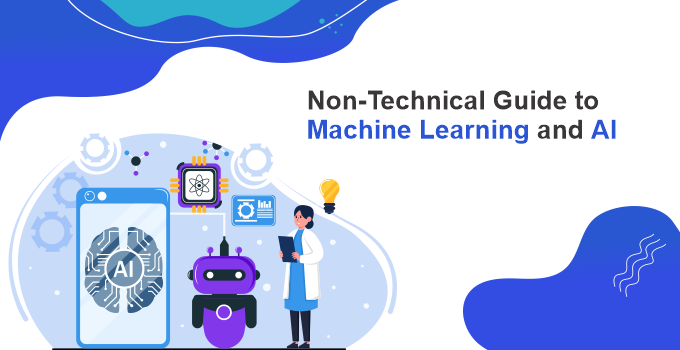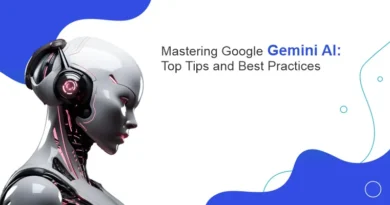Non-Technical Guide to Machine Learning and AI
Machine Learning and AI are new technological opportunities that can deeply impact business operations. These technologies can create dramatic changes in supply chains, manufacturing, marketing, and global health. People want to be able to participate in this AI-ML-driven revolution but they don’t understand enough about ML to feel confident creating new products and services This guide will be a non-technical introduction to machine learning for people with no previous experience in the field.
Machine Learning
Machine learning or data science is the application of computer algorithms to study, predict, and improve domains of knowledge in domains such as medicine, law, finance, and security. Machine learning (ML) is a process that involves training computers using large amounts of data. The idea is to automatically find patterns in the data and humans can either input the information into the machine or let the machine find the patterns for them. Machine learning is applicable in both unsupervised learning and supervised learning conditions. It models the structure and dynamics of data by utilizing trained models of the same or related structures.
Artificial Intelligence
Artificial intelligence has come a long way. The technology behind it has been around for decades, but in the past few years, it’s come into its own. The rise of AI in gaming has led to some pretty interesting effects in the real world. AI has been on the rise for the past few years, but it’s now at a point where it will likely remain that way. This technology will be used for a lot of things shortly, including in banking and transportation but as of right now there are very few people who know a lot about artificial intelligence or how to utilize it.
Click here to read: Artificial Intelligence and the world we live in
Difference between Machine Learning and AI
If you ask any professional where the difference between machine learning and AI is they will answer that it is the data. The widening gap between machine learning and AI is a major issue for society. While the first is used by big tech companies to make smartphones faster and smarter, the latter threatens to take over many jobs.
There are already 7 billion Android devices in use around the world with 900 million apps. This means that 90% of all information in our digital lives is accessible through AI. Machines can now recognize pictures, understand speech and understand collaborative relationships; making it possible for a machine to discuss a job offer with the principal while also performing the duties of a human in the process.
Machine Learning Models
Three machine learning techniques are commonly used. One is the descriptive model, which describes what and how things have happened. While they may not be necessary for all machine learning applications, decision trees are found to reduce human intervention in the development process and enable organizations to make better, faster decisions. In the current era, many industries around the world rely on descriptive machine learning models for several different tasks.
Predictive technology, or predictive analytics, is the most recent version of this model. It’s a new and exciting way to predict future events based on probabilistic theory about the future based on past events. The model is particularly useful for tracking probability in data-heavy industries, such as casinos and lotteries.
Prescriptive models are an advanced form of machine learning. In addition to telling you what will happen in the future, prescriptive models also give you advice on how to improve any negative outcomes. A lot of robots’ decision-making processes are automated, which may result in unexpected, unintended, or undesirable behavior.
Types of Machine Learning
Following are the different types of machine learning and AI:
1.Supervised Learning
Supervised learning or supervised accelerated learning is a form of machine learning that is used to speed up and automate a range of scientific tasks. It can be used to train deep neural networks, which can then be used to solve biological and environmental problems. In supervised learning, data is used to provide the hidden structure for the algorithm, and the algorithm uses this structure to predict the future. It has been applied to a broad range of real-world problems, including classification and recommendation systems.
2.Unsupervised Learning
Unsupervised learning or unsupervised AI is a type of machine learning in which the learner does not directly perform the learning process. Instead, an algorithm runs through a series of inputs/outputs and produces an output if there is a match. A classic example of this is how Microsoft Word searches for synonyms of words in a document when searching for information about a subject; the search engine will look through all the words that currently have a common word in their titles or descriptions and match them with synonyms from other sources if there is a match.
3.Reinforcement Learning
Reinforcement learning (also known as ML, reinforcement learning training, and cognitive load) is a method for increasing your ability to learn by teaching you something over and over again. It works by having you repeat a bit of information over and over again, while your brain gets accustomed to associating the number 6 with the 4. When you encounter a particular fact or situation that doesn’t work as well as it used to, you don’t need to figure out a way to work around it — you need to continue trying until you get better. Playing a game of solitaire is one example of reinforcement learning.
Applications of Modern AI in Different Industries
- Customer Relationship Management (CRM)
- Data scientists start-ups
- Traders algorithm for better results
- Developments in Natural Language Processing (NLP)
- Speech Recognition and Understanding
- Image Understanding and Sensing
- Machine Learning and Knowledge Discovery
- Personal Assistant AI Applications
- Automated Vehicle Driving
- Gaming and Entertainment
- Health Care AI Applications
- Roles of AI in Agriculture, Retail, Finance, Media, Science and Technology
- Security Issues with the Use of AI Systems 11. Robotics and Drones
Why do AI and Machine Learning Matter to You?
Right now, technology has been integrated into almost every aspect of our lives. It’s also a good idea to know the basics of the operation of the things you use every day. Your life is not being closely monitored by Spotify. It still uses machine learning, which is still based on personal data.
With the rise of machine learning, a lot of people are losing their jobs. This is because many tasks can now be handled by computers. However, new jobs are being created to maintain these systems, but it comes at a cost to others who have not yet been replaced.
In a study by consulting firm Opimas, AI is believed to have the potential to eliminate nearly 230,000 financial services jobs by 2025. Asset managers charge huge fees which make it easy for clients to be interested in other ways of managing their savings. Humans are the ones who have to keep track of their datasets, but humans are fallible. Machine learning can manage to have to deal with large datasets and can provide increasingly accurate predictions.
If you want to understand how AI impacts the industry, then it’s important to understand how it works. If you’re a layperson, understanding AI is key to understanding how deeply it will affect almost every industry. It’s important to keep up with the latest developments in machine learning because you never know when a new application will make sense for your business.



